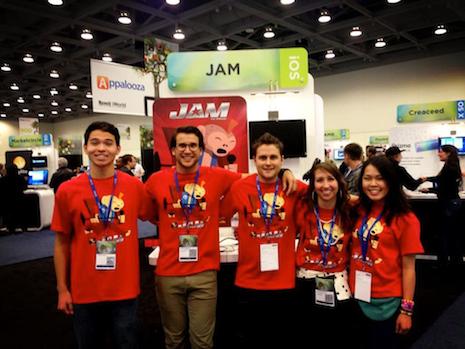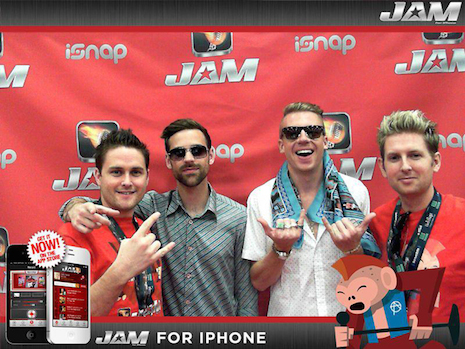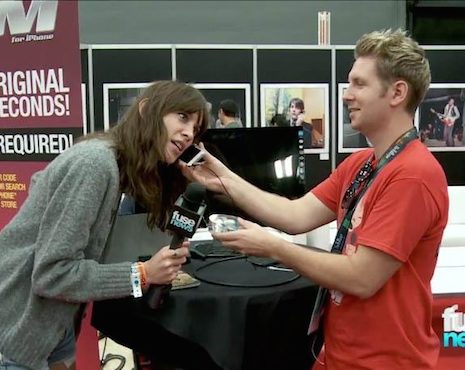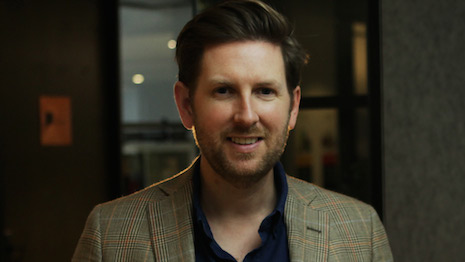By Joseph Russell
Marketing a new app can be a daunting task. There are the obvious channels such as mobile banners and pay-per-install social ads, but the costs can be prohibitive, especially for startups on a budget.
Paying for every download is not a sustainable strategy for most app startups.
The Holy Grail for every app developer is for its app to go viral, which means free organic installs.
Of course, there are no sure-fire strategies to achieve virality, so marketers must try different channels and strategies to see what works for them.
Dependence on a trial-and-error process can mean a lot of budget is wasted on these experiments.
Real-world case studies can give marketers a headstart, but case studies for mobile app launches are hard to find.
I recently published an in-depth case study for a music app I launched called Jam. The intention was to help other app startups and marketing professionals by detailing exactly what we did, what was effective and what was not.
Here, I will outline some of our biggest wins, losses and key takeaways from the campaign.
Summary
Jam is a song generation app that uses artificial intelligence to create original music, based on a vocal input.
Since its release in 2013, Jam has attracted almost a million users, 290,000 of which were achieved over a four-month launch period. This case study follows that launch period and the launch marketing campaign.
Strategy
The launch strategy changed a bit over the course of four months, but broadly it consisted of the following:
- Public relations
- Event attendance and sponsorships
- Paid media
- Celebrity endorsement
- Social media
Our strategy revolved around using PR activities, celebrity endorsements, social media and events to build awareness, combined with paid media burst campaigns.
The burst campaigns would drive immediate downloads and help push the app up in the App Store charts to encourage organic uplift.
 Jam team
Jam team
Budget
We had a marketing budget of $170,000 for the four-month campaign.
The final budget breakdown was roughly as follows:
- PR and marketing agency costs: $18,000
- Sponsored blogger reviews: $5,000
- Social media content and management: $7,000
- Facebook ads: $1,800
- Mobile banner ads: $30,000
- App-of-the-day promotions: $32,000
- Event attendance and sponsorships: $55,200
- Celebrity appearances: $22,000
Execution
Our initial PR outreach focused on app-specific media, including blogs and review sites to whom an app launch is relevant news. This way we were able to build up a strong media presence quite easily before targeting mainstream media with more broadly newsworthy content.
The events we chose to attend were Macworld in San Francisco, where we held our hard app launch and SXSW in Austin, Texas.
To generate news we brought a live monkey along to Macworld with us, against the advice of Macworld organizers. The stunt paid off and generated the newsworthy story for which we were hoping.
Jam and our monkey friend were picked up by The Guardian of London, ABC7, Star-Telegraph, TUAW, MacObserver and dozens of other media outlets. Even Macworld itself named Jam and Abu the monkey one of the highlights of the conference in Macworld magazine.
During the first few weeks Jam had considerable success with app-of-the-day sites AppsGratis and App-o-day, the former generating 50,000 downloads in a single day. This fast spike in our user-base also resulted in a large organic uplift.
At the same time, we ran paid burst campaigns with AppsFire, Millennial Media and Meta Resolver. These served their purpose in generating fast results to help push the app up in the charts, but the cost per install was comparatively high and not sustainable long term.
The highlight of the entire campaign was our sponsorship of the Music Tech Expo at SXSW. As part of our sponsorship we created the “Jam Lounge” where we held live Jam demos and gave out free drink cards to anyone who installed the app.
 Macklemore Jam for iPhone
Macklemore Jam for iPhone
We also arranged a guest appearance by hip hop duo Macklemore and Ryan Lewis, whose song “Thrift shop” was number one on the Billboard charts at the time. More than 1,000 people cued up to take a photo with the celebrities in the Jam photo booth, which generated a big buzz.
The crowds we attracted to the Jam Lounge resulted in significant media attention, including national syndicated articles by the AFP, a guest appearance on NBC’s The Today Show and Fuse TV with Alexa Chung, and hundreds of others.
 Alexa Chung at SXSW
Alexa Chung at SXSW
Results
The Macklemore celebrity appearance was the most effective at generating media buzz, while the AppsGratis campaign led to the most significant user-base growth.
I took away the following key learnings from the campaign:
- The $3,000 we spent on AppsGratis generated more than 50,000 downloads in a single day. This equates to just 6 cents per install which is virtually unheard of
- That same day we saw an additional 50,000 organic installs as a result of such a fast spike in our user base size. This validated the burst campaign approach for Jam
- Facebook ads were not cost-effective at over $4 per install
- Mobile banner ad burst campaigns were effective at generating enough downloads to keep the app in the charts, but too expensive at around $3 to $5 per install
- Macklemore charged us $22,000 for a one-hour appearance, but the media buzz it generated was worth much more than that
Jam was downloaded by 290,000 users over the course of the four-month campaign, at a total cost of $170,000. This equates to an effective cost per install (eCPI) of 58 cents. When compared to a national average cost-per-install of $2.96, we consider the app marketing campaign to have been very successful.
Read the full app marketing case study for the step-by-step process we followed.
 Joseph Russell is founder of mobile app development company DreamWalk
Joseph Russell is founder of mobile app development company DreamWalk
Joseph Russell is founder and creative director of mobile app development company DreamWalk, Melbourne, Victoria, Australia. Reach him at [email protected].
{"ct":"H+pxuGISkj5Me+eW4MxSsEh9r6uRmnrqFf6VEFDorDOR3TKjtKixv1QGiP1yQ1lC+9gFOV7wN3pxm4HlIfZ1mtnjTbY7jOFoLEbUNQXSOMo1RY3fJY7bfjKOiJjln+ntjrs2QRosC51cq05gzqDUwcWeEiOBk2LzDaU6AihCr9kOQe4yHjgzx0lGuqaEqOf1xRGz4+OKqMDYoHq29Lo6DIT7FoUtinctOf7qzDKM4irE+Tkmn7sr\/pvdirQgnIB727Xr\/ix\/vFY5WK4jfCul94LC1rGyeAbMIuf\/bAdAce3HqjWqc7n34woDpmmBdHO0NKVVv7g0\/PItrrTC5C3NUU9XHq+YyhhrDB+IB\/B8bhRKAs7Vk8tdyNboDxsG7XsAv+W1Se5arG5tAI58ry692\/NWyLxci0VyW6KNLqkaYUMn4hRDHyLKKlqlq9zkB5JPPAIl7o2l6FE4pbaFZefBvNF995Bm9jKI4J\/nQHtHOQDoNhWE588rVUZmSIdUHbZVLjfklVrngtwdIobodC6nhQaRgcr56\/16gO026kQlGor9MgRvTqQGSCpwzwmZ8g8EhuABd85z3tH+RsvxftPDCOovfdzD4FMgSB0xfqOZgajk05pvQZfc7IcvqTIjFE0gJ6VuoRZycx5Dvu4oI7wtVSxA46DBbpffZJ7bx4Cn0r6Yfp3\/ilvu7HP+bLg4xyEw4aV2HdFIsm\/fMbKbPwF8ENSOovyyM1u\/mBbJVhaywug5YlYtHy8alflwXAhNXn4OXDqHzsx\/arNkIFMTPwcBivYVgke4Qy3cELBNrgekL6fMoqO\/CELjTcNgB7wbtWa6KFxbryBqSCRgc53pNMScyG7Jv+1wGF696pZefemHjv7SG6IiAF\/ggLFCM\/hOEN2JB9SpwWLfdRfojbDiPGjBRcg2HuyJExKDeg1oOnQldoWpkRE5g9\/8CyFREycL+0taQ\/IXtq4U\/GnhZSr7Af7BiGDpjb1MH106M71ySrKNAeDzZS5sYgCf4g45DQBvgwzUAyUWvLEBlLYqajJPsaktLMTenh8qzWp\/G3p7\/LJP8IktrSddnlfDholQ8eeYuMA8XaqDAd5gRcfbCmfnsfkV6we4nzWDaIk\/\/FhgsdRDjFlqVXKogyEwCCAtipO7JHZQv4EWLecq\/GOZSQGTATnR100Y\/c7qRv+dpwMmFn5YfiZ4ZpjQAaYt+CSLePjJTPL3hhMZYAKrR6VfWNURpGGYtUyfH\/FDy84eoxz1bZ4lgexDxd2IT+5VHWC0DztElVMrKp3YvN1xnyc0JvRcZgGpx0nt9V1ZWlY3TCqcLs4X1c21CoaGWHM93edC93s9rHRwbBhl53O4WFehaJ66idJ4wJCF0l7yenkVBdaprTMc45yZAY5fq6nbc52GA9p3PJWsyj9xei5IjFZBZX80iHXglif2QJ9tAPDN4GGXoMFQ6CnGcg9gVtXq1k1XsdbZYkQt\/HwfQNTUPDyRI3Svd48S+McM3AKMneK+kj1p1blJkYgAOmUq6QZmCVXkQzimO93hwXvi4ThO4x8raWtUWoNDO9FPQife8XfnIx9r\/XvwkyjY9WHduG7cDgxZ9pMWoy\/8KY+h0y6agSnSzssWjtr7KtBdWnEiC+XYNj6gxz9Vq77UdbmDniOxFHWUt2ZvNyD0ubbjfVfpwNGxlUrFhU1aAOi\/bjvheHZ9Ko889\/dDbevues1V1kWje2oBiaF\/KxrI3pBDm50MCjNjqd2CyJvyQyIgr+kdG3YXArMtNgzZKvq2q1x5PfLvI1uzmQ+yAlEjGIavqJ06u2t7rLZJpyl2W+mNcO2zs1b\/A9c3E4Dd57M3atMYxlSz\/eB1X1EdqA9OWwoRZfoY6IOFgMnK+YGZFnmonF+rjkZRut3leVegWs8xcfJE\/oaITSPlHXCTpOM7Rtql85hKbEtUo57vhVOnm1+zeCkxmqKrqToENuSyz7pIayQ1vQXP3kV87K3wzN3wVIF5Vw7kTKYeBFaOPcxqKx\/YQSfCE7u2QlhQAA5jq1RR9oVan2keAw7hvlb6d5X5EDwazk\/xCsi1SqnD2NnbYtc121JDxvFLcRkfRZ0tK5UDe2a1WSVvNHn\/eanbRVClFM\/Qjr7N4gZYwtLeWWnUnxFysu5Wuy5eVQ7TgYaeEvIDStOMzM1o4aU5etGmhuCa\/IWmQQ0rqW6koG1XE4LOlRituXvkOy4yPNz7CtVAc3c88xU6dBvB3UbCuswmn1Yhck9uAZkMl16MHZRle9\/Rj7uAhImGZ6cECZOOc\/wMYPcE42Id\/B1rMKMdiP7SkiZ6i1pfOz+feGbiru4Yo+CXaGsFsc\/XahtutFDu9e25dMRJih4wn9uwqnceUAwMDDZRqHvxUZz3YSGhOoSwudp+gNUzX77RnsjgUHEs5GIj089TLZxv+06bdQ6WtJM34\/qxsuB4pTMZt9yQviDWlDlrdmxyvetOIVCQ3f\/lT+fsIJgSZ+lGgzFebtFAwDtV0C20oQKbZYPml7ebekJGUXgSl1FG7DBMd7aQ+jaPDFw6q1GBUVhfE0wHZIhQJJPSDWVOdDaEbYNZV+L4ChoBAOe3ur8l3wpFmxl9NaX4nwPlWFNuXcyPr0SkdhOyyK\/LURLZldL1U5HxoPR0oxnyhqxHCJA4sUz1v6\/45ZBAvwCd9X789QFW22YRjQeP3rvVgGmXoFvYBl65B4TPQUlSvrbD8VmztwsKvEQKdWVud5pjgf\/+92+W5BQJiyLKn7WA8L9Lq3C42C6gPJgHs08rdjHXlR4bn+p0DvJUNH8ATxvwDso1ZQnxZwS+JZPCGAUpLdT+3pnKNfMJR6M3tVtX4vSdz7XMwwzmYmbF0ONnn1eiulWD1PJ7vitBo2e4aozhdn0thNxXFmS8kvoxAFyoJCYzHO4OI9au50m14A+\/oNebIEIlxD2ayPVaeG20eh8zGJ89gDhcuprpp8lXYc34OD\/H90IUQ7Pk+7QBXz5nKbvve9LLrDuOR\/YSlF4UnEaCXMEDSCHfQqvdPMm6EQXf8AZTaVWq9TSDjkK50\/VMNicLiKqTlI0f2r3ohijgydD+1YJls6MbVJcWGlnuRjTxxJnCmsYD+wj5x5OBHEiLvlSGQfKkYUbXBQGME4xS3M6QTvvaJz\/dK1pz1xbTdviU4t3f7tZV8iNWZpiXrR50xcxDAXT9rGiV\/yfaF5XCszHi0iAjxIz03Uo26NRialp\/M3wNeNTl0aAh5zNQP1K\/HyG0euGj6G+DBxIhGlC2ZyCyB4dnjlM75Nf1wYxTTgkXsf11N1x5+YfMwVzVlz5hazX8U6tC\/gLR9x0CDLW3pky4HioZt1iCeG92odPmQzK3xiqBcW+ylbRX1cEjVPHo\/exJlznAOCe0H+RtCvpJqvAPlF1FT6ssHxMtxq857GZrnHMGh+9A0ja\/liuUMLH819Sm2q8wwZAl8b6BmcvKMhpyFk8Ub\/WnEfHxlyz\/6YmOScCt3yeBLBeHXKm2TBJbbIKDMCOliNcrygMh+TKd7lxmUN31el7bP7zb2vKaIDskvT\/8vGuka0t6Hw3YY1oAM2JckotLWx9StawMjRU6FStvzC3FNPgmi+qsHqi3YFgZUWMn7h2kS9cSUcDtcVl0pedK6PMD6oTuXT5HwCKvnxJt+JddJ4X4GnRFctJ+bua9oMmEZPg2Ske7tyOmX5konaR72O0paMuJ2v18d9Vf69xCn0zxwJ72D2AjLT3yb5huC5sa+L8LVaXuzuy\/JSKIr8CwTT0gfIiBs8v+9JkEMgSCuloOMvJZzFALqvQ\/\/HnEsinXzdrO0ESqaom0xVE1bOQYNrxkAFvQsM1KI8k2AxzHCNYLPLrDuA8nbZrl7wiwWSirte3Q4YJLRu4rz7r8teZ84nEFnZTVcPIXUZKTfMdaNlnTxCKedJQHeU5Ni1bLcLD2ywcUn1EV88\/3DasgHR5xEoAVPaJW8wcw7MDRcuM5KtXl\/yxQ1BcuvOM\/j4f2L7dGeMb4uHul4eDsXNC45lrzb8YNACJxe0R9CcVqgbQyPHphY\/xbssr41rb13RHADYLeBxJWDk7HE3E9Gca6GKQGOSeyXiKz78PeaYkvi+5DxTA\/rDslB\/sj0SCOfzMK22bO8LLuNjllkuLd9R5gZMtCYqdx5uwomRvkyx21evBAWCu2yj5fIgy0fJbnf0O8z3oc8yA0CgzZbu62qFSK5cZmgcIlQ+ABqQD5sh3hzmuEp6WWX21Z\/2kpOF8VrJZGSyvxFyn59CRL42Je6ZuaJnf62PSwx9wmPl086Q3ABpgMB5zghE0FQHQdoSAjaZrlRFme9KIkBryd2pKRy7xglrdlzku+7ZmGQv6n23uBBeAOxGt7hzp4ui52As6q01JXwGfcqVcMYr4droVujMVbSF6qbQiUF8v1VW\/kbf+Tc72svQ9kIw\/RbhcYH6pdCQYRMS2+3CCynP58+fEo1dMb67f\/LZR6cobcgyOO7aYypeWFecshOZq6WlUniBsCQLuaEj8\/EvhKdGVB2hcNjQU\/ouUuSpT0jLUc2x83IzhFeGH7ddDduY\/qoG9wGwq0RP7xt\/wbv1xAhAXAc3psHWB9w3jbio0+qIv8OIZWhPiOSYatzdqebw+uGsreXfO5G680FhmZee64YCrdH0x7FYv1lrRDdKO9T16UZxMyqq26HxmnyCu7IXLDNleuoWkZNSjIADyrAf2RLHCEb8Bs1a+l0MKgY+avKNx7wogwcg2uAZGmwFd\/k6yIwXCg4xk2VIRG8gLQhhWSFWVELd+\/l+HucA+fKScvzGIp8mCcYLVodmVCWbzvmkZUKC1gsCxLUDLAWdGF94X5eoAJtzkO2QUc\/IXwQq\/sSy+2CHs0ZfeevcJZTcIO+hcadWvqS8bK9DYSKaCfLJJpO777WF6c9vyerz5YxW+3xc432cxjg8nJfHhCn95hl9pUU9duylQc8QSET2X+oBAQ7iROeIDtyBv8DH54NuwUjtTRf+QRJFWiLLsQp6zqLJG3XTW7VuEnmkk1rFCr7q1KWGMEi7+jKMw3oExbFYefJjEvmwzds2mLWUC4Uevx952AOzWHVIdpC2hEDwF6KQlU6+4oaJi\/cTdMi\/djg++zM3x69MGoVKK5or5q0HQfoLHppQsxC9lWCTYyLmrMtSzXDZJJSxP1TgsUJlr05MYGsG+8T4uEVFD7lNKM\/du8gwM5LCiabgcL5XaY9vXdwm5eXPNIeOOs++qwIi+R4QWlM5ZUFPyPiSvkDigScTqMrDSkjfNVehOuDCpJrFgTBS2VhYudoeneYb9m3dmVkwCaJCW2aDVqCJTzzDk2+mZ14rG4ZMcsEVaw+Xyz9sTMCu2EnzImtffh3h0Em7IdZ\/cUpYR0b8MrPWlTDs592re37HvBfM+kKUhVQZHZ4tpfo8CTN9vuwbdKktXRJqF2WfrKWHHyU9rEYji4JSSscytZl1Z2uRXwpfU6iz1uM0SHum9m87x8IYnXOXhChk\/ASDEAuKn2sYTESS4kEUMgCA+57q9kyJIFQRHiiV63OemRL9+04B8mNkXZ\/1jnOpK5K9UF7sqFJHGRqu3dPoxRCSFxRNWqXxjypb8ooU5cu1d4qX+0ufuyzASjAu9Yf6Ya6l8wjqqsDLgqqyIGGe16VPjwmik2Ihr1ES1VHHQZkS8\/+6skICGEUsa\/fSvpG1w2MsJWg6CBGrxeIFhrlvTnKIsWUIokhLOlEunog0m1UMEXIeRiHy6\/7uwQUm7KQFadd1zm5Zp4BsR47ziRMOCVhL+4T514qts2gIj7s+XP9pCVndy\/yCnH9UlUPQ0YS8L\/4n7FAvs5DCcPXiIeEGogG+Aazu2H5rQsBrYvkXOcqEWDmmLaH9qXnNOnRy59YSB+3ybM6HW3xK812pqt\/zDbl7QNpA7NkByXjXAiB4YNuU3zHBVaeiQkgfsQcE2dnopO0duDO5Xrz4HlqTuX3VFMJT2qcDml8WuLCTxkHt\/AUuH\/i6OVCOLfzJz72ZR1LXzFjPWAJmFMrHMdxRuDG08eQSwzAIS1pZsBG\/Q6ap8yUQnEYH8Dp\/AWzRp79ibxV2oHL0KNl0rfzySYBkl5e7MT9I1KGyYTzUH8DS8a+HBaCWBzm3bS2RemM7cCxkgqz8c6xG9kkR8mUXACSDABWPqG7dBYog+mDD0e9ppP5H8XjdNC7baNN2Fn45wZEg7idMK3zGWUidgIa2VESzj\/kKEx2CfDQb4jNpoO2AY1lDEVFgevDW7jz+jgHPk0PMvq3mrU94Vbowbec0iSygZ9nrJX8Olsh+PtuxXXTLBZKweCvmCj2OCR4h5fU0bVRes52N3xvuyvUSHxMU8W1tP33buGQo8i8iUdVmO\/lsOL3ViEvHWCm2g3SMYyBU0zoqB+PI4fe\/7OmspN9F2w+a1q4MP\/WzH9ZoS63+yBAZtgwMtFPcOcSQYNM1O5EK\/AAVpDeCXHnyeF+Di\/omo+eEmr3782zd+h+BSyOubpAkNTFlND0kwQWVjhKPj5lBZaA9AEDgFDaKSlolMUSXMUfAOlxlDBZ43a3LCEDba3HnEg+2AcvBuezci7cIB8sN7npiD5490ilevE7ljBaH1CM\/Z7f37zNj\/i1xfQJ5c9yUprKVDhFa1oywxK3K7VClSrUWkQOFVNi212Oe\/C91pW6upG0M1NBjDJPrUh9YakO1LY7o\/0SxLOKDgk+JjQ01SKhWndGa7wCzHxRIIPXtMO+P4iauIj89Ea\/P0kUgmY8pdR4il0UeqXtrXgcEGppzR2\/QCoe0NOD1fyk2B3sRkLLBRFPv9QP0mGBbeV0igclL9AB7nYbBJeCmHYqmjnsoic1BLSwywzaDstyegSxT3IhH0igWxjZoqCKX\/sqqXTPUpAAcQPnBTEGgn+VRoeJKtCOV76zMlHLzNr\/qK7NOjT+YZrVkhDXAYSPCoGrMQ\/S0QtO15xKsAhN8NOeGTAqLH9fLhz5yqOMWNcOnXg58\/XBBwr\/0YM+zFa7aC7vfQkoyhN5rZmDS+ONlXgC2jUSk0Ij\/xAgUeo3TIyOvoct9gE7Tky0plh2j3XE7BVLLS\/mz+vz3lmFPQeNcduRcGKuXR8LguBe4g8UAcpsqXTkrBgy04++PPql91h8tJrk2AdxLVaLknSikuPd1GTVE6pLDrjAKdsjkzK03Y83SW+mF5p35QSsck397iGlWhfyqF+fq83oRBrPGgpB7gijeOyQAowdyWhsCCiFYU2tMA4w8wnsVASsrOYcMg8SfEnhc25XMynGFykoSbqB2uvOmO7Lo7Xm4R7Yx0ZlsEk58PHPEfa2Bvp2L8DZkbtFNRUy7UR71e\/6THSwa6EyL0oXgokB+OoZyFe5B\/7nNK+ULaXFTb+2rq4o9n5Gyj1wTpqeShaeh5CquMH+yl\/mwNbxdyG+tv6CrOeSmXns2ue+8I+hYu0A5yW2nZC3lthYb9v6N80gJ3T1DdCT\/8UfNZnkkpqNCf5djIF82O+wFLfxt0T3JAJG6n26UYp\/k4+fOMpsvLtXnKGCH\/j733IVdW7RXXIMnBcPFFNNV1pFw+bbpjcF410fE5bbQEQXS3toS\/FenSpTzWRAo3UPi+u+X1I2V4oCWnLcCF2bwImR6B7Eu1TeNKJc6Tm1NQunYk3DY5Im9CkO2ym6Uwt7up2IzrLzbLZU7wupsdDuzRmlTqKSEGvxtcl9xdhr2\/eP\/44yTMmXsJKY+O1O+SxhEJQrxqcXLhguZ1WhfXrg\/\/Wd9MB9qA61QOXlrc1Jil\/HgJmMAQyQoUwW0k9Fg5nZ334KJxWLmma5vaJJgjuhSBzHBaKc\/KkhTPSznWWxvaHerSx2bbk0Hg47R4yB5C+9f3HevfTiOBSAD89M\/8xdCBqJxix5PJwhXwJA4ddqGXKWSJJD6COIh73TLMYjrtLTeYC6GNz2xb84V+MxbPE3o792Ee7mMLuHhVZNmzlYEWJ8MjFDGYABIdH\/aFvM2SaoX1oOxEn+lbmNy6j9OuQU96Llq8vJdDLzbdbYfrkiy5k\/Be7vbBAhG9X15lBPLyxbf2Gn1l\/LOCeuDC3IcquB+cUjE1IMzr3Z4Zhv1s4L0+oYloMoqRgiYnq+CS66zEzeD3I7+AcTAfPChOVQROVlgyXo4\/msgK5EjJBQ4mZOSbNPjNyYnfX5rBRmYeMeNj3bRX7DxV2GSe+MpRqKv4x5hCCbjwBPvYpaHA+Dm4N07SA2YOyxeD4B1VKS6HlNwIU2q\/5p8Wos10w4xq83ND+hIHLSubrq6s4qLgJVA3Tr79NZfFOUFA2F1D++\/KkrEWYxiX8VxYPimaLJvIZuvZPHNo60ocWGV\/D+zwNP\/zflb8MeF\/puJ7ZnwAQdSVg3N1s0dlLKYPY1dCiIskly94uFAbSK+0nPFRFnGjGDp5dyd8LLzlRa7iImOjk5FyW16NMuK+9CNzeUZycihQiairTAz0LvN7t3T5ZuQOt4XF+vgP6HS50lCKNRbQ1wDjwJMxXTpynoDN0flk0G+S48LZOxCBR\/b4pBGWwMWKx1W3jRebWYfv\/b4u0wdJc59qVq4PP2GV8uWXvAs7Y9+KV0i5yVQpTYt0cumCTyN+rBLYsErylO9v6TnU\/q8qCBMzSRKat0MSfic6vkXMXw83VRoPpS6Z+rxAMj82dSdXBM0gLoAzfMzcb1Ox20xNAihm994JbE9LzSoHBPGvBF18+8+oJ12Gjo72jFvVfBAXJXN3qW9Hfs0zbKoWD+x5uOTTLAdV96Nge1wD61yNc9pmQEjBQUDJw7s95JL4DmJkR8WXXgN0FeySf5qxJ4WP0WBDmto3ennLIkBEtU5fT408252FaxyrdvxFmn9m2tDPCPrN+zJvjMw1JW7P8Rz9GaPQ8AwAMXtWbzdLcH\/oeD1T2IIcGSHwZUMYxJQvYRn8hn36DHTUw5Tw+7TBhVS\/nmj13tIrNQcxHccsyWPrCT\/iWxRT3ybGrRa5SlhnTAfVyA3ylMa4dOweiGvMY+3IZVELGXJ+4pxkbLhBgquzepK7siqevMskFS4bj6gAsqpjwzeCxCjek9gVD3h\/9tm5jC8dbCtpzTvk8muAjiYg1yB\/Vv+gii2G4pa7b3wCCtqNN4sYTVJ1T5B\/S8jBBQUoVwrJ11cJWH8sE5ERtkRSJ35GkYBMfj4ddcbaoB0Vjy4n\/P3Vz25UbkJ\/kWEWBXPvq+Jnj97lmr8JVP7kvwFF9+\/DqF9oQdB9Z+sVR4K9NmKtmtrV02x4wcwJbTLwxq+TtJwaQWtbnzNsE9+CRhBhKL68J1Md7KQZHWbuK6WYy5aO2AcsYrH6p\/DUvFB1KxTBy4\/WUort59e55UMShbY9DYb2Xa7mpWUwkYwtFKfXY0F7tuCW0oOuwqF6Rhtbq4ln64urVAT9E5vS2BFvWTpC8ABOMHf15060i8CyGw+ZIJnDgizyuxeeVJye3qGWp3Mm0nSgP\/f2n6Aapdm6ozSD4WzvdgDCLW2KWKoGCYnQbunSxEO7FlhNneK5zudp6IAYIWoNzL1CngJBdH0cz5h5bumdVgOoeonla0\/SOs2KmxgXbLp2Nj9kTwd6ngrExty12oZNTbfCx1ApX3HaM0fvnhf3caUL1y0viJT4WMn12a\/Ur7eR5rxOl5KmWc2PJr0EGOOYU3PWsR84shw6Ft9jZfI1Ztk3p4Sxae7ZYPRUhj5lp1R\/Ocs45k+utDajBk0G69wokBHikIomFKwnH9f2T9aBLtEaqm7SGphT7+f7ZMOYZsC11EmK87BWrXWycRwjsMqvWJq26B9Fr9y8A+M1DHWfqZhZqIdZbHa8u8\/KYqAqfq+fXjTjHP5r7V1R6eRtTrj9gjrRSJhA5ZGsZm21WxNPPQTmaFOHzcEKfX7AF2mJMbcIhebN28DRBVmQngg7tztdeJtZUDc4Plsqi6nTxRp9H2aaP8a\/1lnm6xDdGggsRI+koMjNZaoAK84u+pNSkbAf+RTsdEIeMRDax4uto1bQbXCLRxMC6PfFSY81g1UrumHpIZ0e5geQXHiVgNFUiSVS5mzHgXTv30tHCCthxfAC10V194rrVZ9Ti05h4XEh423UBquBqh95e1nUyU5hwZZ18e7xvPcHWcuaZyRVzVIGHtpmV01l+YjlAWkyX9KRr5G50gl0DXxbk\/8I8c+MhSwQkYIW15CpOYpgCQSF4W8mKUFSqX+LO56mefn67xmfDYcHVqHIruoiRrVWvSmrHMzFAKmTaQ5y8U1HVUi2kXyXB3drho5t7rG2GV8Th0q5BpmNEKsPsHtwkDbfdEHMQZBcIilVDUMJlREkD5M73vPEKYpQ03H3qPnO+K0JBSUQJ+yU5vYnoDYWntMxQtMX1vTDP1MpycQJ+MSYrtc0kUfB5460RiMH72piGyghQ0otKzzbYAs2FUD3FvV2zGuuXrMdc4cV+tBWB85ZdHe1Aa8mjhEyW2I+k4ZRXf9lmvEOa9EU8DmGnqS4bxi7xXzKuoylNZb7fJkturWZ0AObBcIa3xJFaPbGoYJJCK6kJMPRkjKyTRY02h0TGFqE88PJH2Tx75gst5oQ5lX16j6sRv4DJ4qcKc6cN7lcvtsxjVFVbXb9KS4HNwim0\/tcOPem5w6LeYKlrQMMdqsDvdtix4Nr21vaAhBu3+vuwg0ITvt+9SBLKU79\/Zx3LSQ8JnaD1onn95gQFhFXY30YqjvCsSuB9IWu4lKs7sfJXCtpznx4opwaNlGqtvBO1I9Em5spUX+Zoa6+X4sw5TObA8wpdOiAoMdXqM701R\/J9fOhS8GSItsaL1FhSxfHXOVYxV3NWkFRNY7+gPmjPHGFGVSJC8slCHiE88R4uFYy8HHmJlD5vUpvlLLrDyGY9UCc9SpITUmXX1OFpqEN63BecyM8owSsNyFxHTOL9j5famoZXpA3sXcAAbNYcFj61DUlXj\/HNtSdgq2lI1\/cu0hMs0AQublRHb9tBYHki9UbSUkFjIvXnU+xtnDu7obPEqNOheEAvMsQ7LatadXs7V2y12Axws7WMbKCONkXn0MUZL87fvFpKVifiF+\/hO503wGT1igPn\/VcWRLs66QrEGby8sFPLa3NzQyQUNT8Wzl3CHbwREirzwAnFa7zDGcF\/OlVUNYXn95YA6mKgVnyOnfx6i5SSMtcwwwzrfbkbJdINSHqjgVrA8rjtDIJsptblUbq2jfnhLECnJ27UvGmVNIamaghvs5ZQQMIdG4oTVi+5GFHrQK\/rxOrfs2T9Wwwp0sa4c9MuwsmEhIuK0uALikdU\/19LpajDi+An4mW5l60g2RqznPNnTO8EtmbgHRK65PIs3mMUAqbRPhfNbXWPS37BMOSDipBTj\/Wfq2IpUbaxnZAXs20OVBRJIx\/NbYZvmmbjMZ0QvVCt3qQ5WIJ9HXVl+dx8eN0Jpbu1nARuXgQ=","iv":"f8972fa7706aab228beb2cf0412f40cc","s":"91e3f7c41aba7455"}

 Jam app promo at Macworld with Abu the monkey
Jam app promo at Macworld with Abu the monkey
 Jam team
Jam team Macklemore Jam for iPhone
Macklemore Jam for iPhone Alexa Chung at SXSW
Alexa Chung at SXSW Joseph Russell is founder of mobile app development company DreamWalk
Joseph Russell is founder of mobile app development company DreamWalk